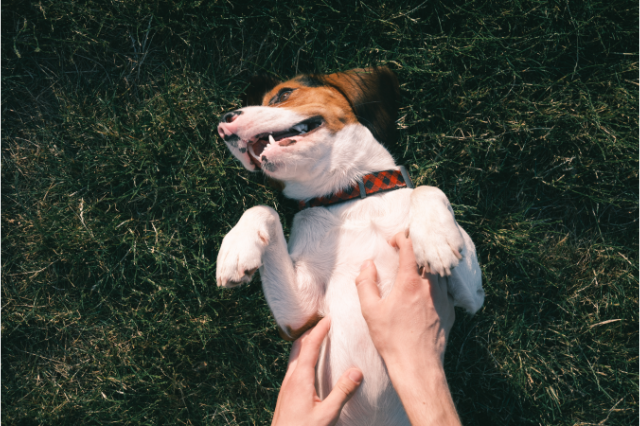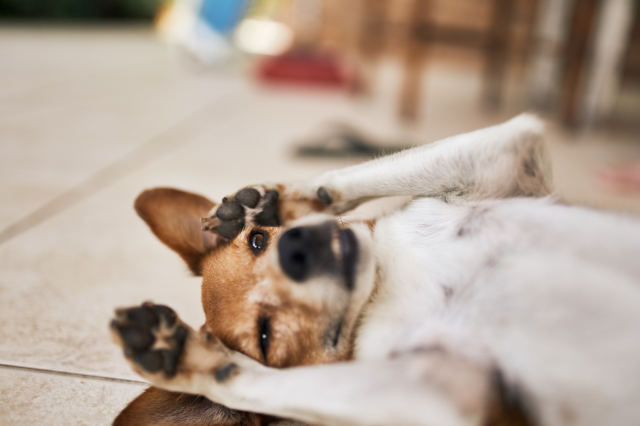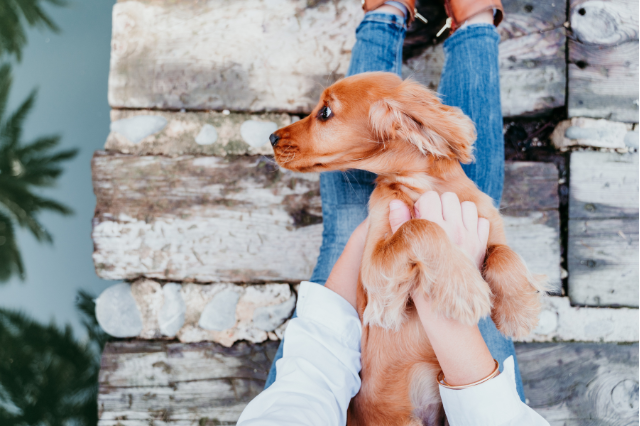Why Do Dogs Like Belly Rubs? Reasons to Tickle Their Tummies!

Pet owners know that cuddling is one of the most rewarding activities of keeping a pet. Dogs, in particular, seem to love cuddles just as much as they love playing fetch or gnawing on their favorite cute toy. A dog would happily roll over on its back with its tail wagging and paws in the air to demand belly rubs. But why do dogs like belly rubs? Are belly rubs any different than petting other areas, such as the backs of their ears? Should you pet any dog that shows you his tummy? Read on to find out why dogs love belly rubs!
The Science Behind Belly Rubs
Dogs love a good belly rub because of the way it makes them feel. A dog showing you his belly is a sign of great trust and a mutual bond between you and your canine companion. Generally, it’s a clear sign that your dog wants their belly rubbed.
Dogs love petting because it releases endorphins such as serotonin and oxytocin, the hormones responsible for feel-good emotions and bonding. This release of chemicals makes the experience rewarding and strengthens the bond between you and your dog.
Some theories suggest that this fondness for belly rubs stems from mammalian traits. Mammals have specific neurons in their brains, which respond to external stimulation of the hair follicles. Dogs stimulate their hair follicles by scratching or licking their bodies, which is how they groom and clean themselves. Since they can’t reach their bellies, they require their human counterparts to lend a helping hand.
Dogs Rolling: Submission or Trust?
Just like humans, dogs have individual preferences too. Not all dogs are big fans of belly rubs. They might be rolling over for entirely different reasons.
Showing its belly puts a dog in a vulnerable position. It can signify trust, but it can also be a sign of submission when it comes to our canine friends. Submissive or appeasing behavior indicates that the dog is trying to calm down a supposedly tense situation. Reaching out to pet a dog who is being submissive may trigger nervousness and anxiety.
How can you tell if your dog is in for some good old belly rubbing or just being submissive because he chewed up your pillow or was barking all night? The answer is body language.
Dogs will generally have loose body postures with their mouths open and relaxed if they demand physical affection from you. With open eyes, not focused on anything, their tails will be wagging and relaxed. Pay attention to the sounds your dog is making while lying down. Delicate panting sounds suggest that they are in for the belly rubs.
In contrast, tense body postures indicate a sign of fear and submission. Dogs will have their mouths in a grimace of sorts, and their eyes will be either focused on you or staring in the distance. A tucked tail and squinty eyes also indicate that your dog isn’t looking forward to a belly rub.

How To Help Your Dogs Enjoy a Good Belly Rub
Dogs aren’t always looking forward to a belly rub. So if your furry friend isn’t reacting the way you want him to, maybe their just not in the mood. You can find out more about how and why dogs like to be pet here.
Dogs enjoy having their bellies stroked when they’re relaxed, so don’t force it if your dog is kindly declining your offer to pet its tummy. Here’s how to assess your dog’s body language and make sure that they enjoy the belly rubs.
- Check for body language signals to see if your dog is in for the treat. The pat-pet-pause protocol is also a choice method to figure out if your dog will appreciate your advances or would like to be left alone.
- Your body language should be relaxed and loose while approaching your dog. Dogs put themselves in a vulnerable position by flopping over on their backs, so it’s best to mimic their body language. Kneel close to your dog to give a more playful and affectionate vibe.
- Start by patting your puppy’s tummy. Work your fingers in a circular motion around the area and keep alternating after a few seconds. Be mindful of your dog’s reaction. Dogs have individual preferences, so your dog might respond better to a specific type of rub. Try different motions to see if you get different results. You might find a petting method that your dog loves even more.
- Stop after a few seconds. Let your dog respond. If your dog signals you to keep petting his tummy, like pawing at you or gentle whimpering, continue where you left off. If your dog isn’t in the mood for any more petting, he would probably sit up or leave.
The most important thing is to know when your dog wants your attention. The experience is all the more enjoyable for our four-legged companions if we approach them the way they want us to.
What’s with All the Kicking? Should You Be Worried?
Many dogs kick their legs in the air while you’re petting their bellies. It’s an involuntary response known as the scratch reflex. The scratch reflex protects the dog from external irritants like fleas, ticks, and the resulting itching. But why does your dog do it when you’re rubbing its belly?
Dogs have nerve clusters in specific areas of their abdomens. When these nerve clusters are stimulated by scratching or petting, the neurons signal the spinal nerves to trigger the scratch reflex. It doesn’t necessarily mean that your dog’s belly is ticklish or that it’s annoyed by the belly rubs. Most dogs enjoy them despite the kicking.

What Should You Do If Your Dog Doesn’t Like Belly Rubs?
Not all dogs enjoy belly rubs. One of your pups might be a big fan while your other pooch might growl at you when you try to scratch its belly. It’s important not to force your dog to “like” petting as it increases fear and irritability. So what should you do to bond with your pet? Here are a few simple and fun alternatives for quality time with your buddy:
Take Them Out For A Ride
You most likely know what activities your dog enjoys. If your pup is fond of car rides, include them on short errands like grabbing takeaway or going for an oil change. Choose a pet-friendly drive-thru so your dog can get some treats along with you to make the experience more enjoyable.
Go For A Walk
Dogs love being out and about. You can arrange playful meetups with the neighboring dogs if your buddy enjoys them. Dog parks are a good option as well. When visiting a dog park, be sure to choose quieter hours if your dog feels uncomfortable in large crowds.
Keep Your Friends Close And Your Dogs Closer
If your dog doesn’t like belly rubs, try petting his head, ears, and back. Playing fetch is also a great bonding activity. You can let them sit on the couch with you while watching a game or a movie. Toss them healthy treats (such as chunks of pineapple or cucumber) and tell them how much they mean to you. Check in with your dogs during the day to see any signs of crankiness or nervousness, and try to identify the triggers and mitigate them. What matters is that you’re spending quality time with your furry buddy, and they enjoy it too and crave your company.

Conclusion: Why Do Dogs Like Belly Rubs?
The straight answer is that they love the human touch. Belly rubs make dogs feel good. Dogs generally love petting, but belly rubs provide comfort, happiness, and a sense of belonging. The stroking action of belly rubs involves the stimulation of a dog’s hair follicles. This initiates a feel-good response within the brain.
If your pooch is showing you its belly and expects a good rub, it’s a sign that shows how comfortable your dog is being a part of your family. But not all dogs love belly rubs. Assess your dog’s body language to check for stress or anxiety. If your pooch isn’t interested in cuddles, you can try other activities that make them enjoy a special bond with you.
You might also be interested in learning about why dogs sleep on their backs. Actually, there are a lot of reasons – find out!
